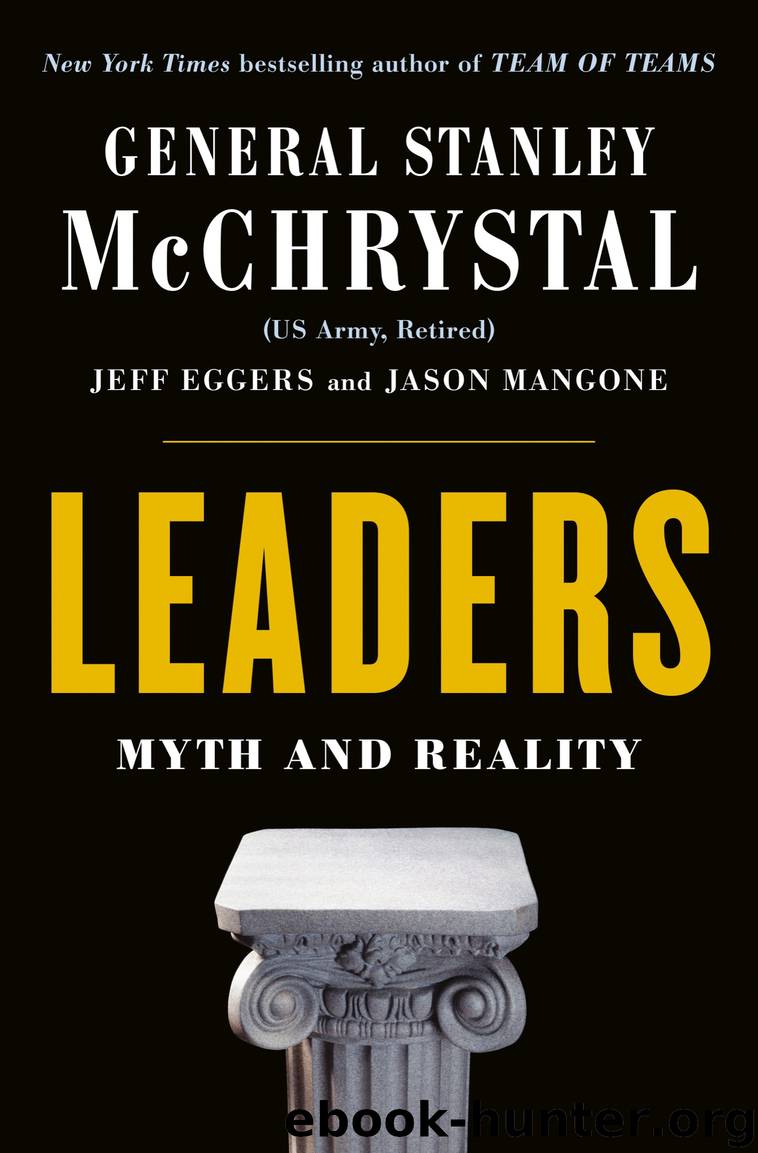Leaders by Stanley Mcchrystal & Jeff Eggers & Jay Mangone

Author:Stanley Mcchrystal & Jeff Eggers & Jay Mangone
Language: eng
Format: epub
Publisher: Penguin Publishing Group
Published: 2018-10-22T16:00:00+00:00
Lead Tiger
New York City in 1850 was cramped and loud. But it was not yet remarkable for its height. Rising only 281 feet above lower Manhattan, the spire of Trinity Church was the highest point in the city. A few blocks north sat City Hall, its cupola a bit shorter than Trinity Church. Twenty-four hours a day, a watchman stood in the City Hall bell tower, on the lookout for fires, a serious danger in a town still mostly constructed of wood. When he spotted smoke, he’d ring the bell, setting off a cascade of other bells positioned throughout the city. If it was daytime, he’d raise a banner, and if it was nighttime, a torch, in the direction of the blaze. Then the dozens of volunteer fire associations around Manhattan would spring to action.
If the banner was raised or the torch lit in the direction of Manhattan’s Seventh Ward—only about ten blocks east of City Hall—then the “Big Six” fire company would have answered the call. Under the leadership of twenty-seven-year-old Bill Tweed, they’d race on foot with heavy, man-pulled pump engines to the scene of the fire and hook a leather hose to one of the city’s new fire hydrants to fight the blaze. Local citizens would gather outside, watching their local heroes in bold red shirts and white fire coats, or the spectacle of two or more volunteer companies brawling for the honor of being first on the scene. Firefighters were local celebrities. As foreman of the Big Six, Bill Tweed was gaining a reputation as a tough and gregarious young man, well known and respected in his ward, and elected by his peers to run the seventy-five-man company. He was just the sort of talent who appealed to his local political organization. Painted on the side of the Big Six’s red engine was a snarling red tiger, an image that came to symbolize the institution that brought Tweed to power: Tammany Hall.
Tweed once pointed out that by 1870, “Tammany Hall got all its powers from us [the Tweed Ring]—not we from them.” That may have been true by that late juncture in his career, but Boss Tweed’s rise to power was dependent upon the institutions of Tammany Hall—indeed, he oriented his rise toward the pinnacle of Tammany leadership. And while popular lore identifies Tweed as the preeminent Tammany man, Tammany Hall reached its peak only after Tweed’s downfall.
Tammany Hall was both a building and an institution. The building was initially located in lower Manhattan before moving to various headquarters around Union Square. More important, Tammany Hall was the institution that controlled the Democratic Party of New York County, or Manhattan. While the building was beautiful (in 1868 it hosted the Democratic National Convention), the organization was much grander: at the height of Tammany’s power, they had to rent out Madison Square Garden just to accommodate half of their membership.
The institution lasted for nearly two hundred years, and for about a hundred years from the mid-1800s until World War II, it was the dominant force in New York politics and even shaped national politics.
Download
This site does not store any files on its server. We only index and link to content provided by other sites. Please contact the content providers to delete copyright contents if any and email us, we'll remove relevant links or contents immediately.
Hit Refresh by Satya Nadella(8851)
When Breath Becomes Air by Paul Kalanithi(8037)
The Girl Without a Voice by Casey Watson(7599)
A Court of Wings and Ruin by Sarah J. Maas(7249)
Do No Harm Stories of Life, Death and Brain Surgery by Henry Marsh(6683)
Shoe Dog by Phil Knight(4882)
Hunger by Roxane Gay(4676)
A Higher Loyalty: Truth, Lies, and Leadership by James Comey(4546)
The Rules Do Not Apply by Ariel Levy(4520)
Everything Happens for a Reason by Kate Bowler(4474)
Tuesdays with Morrie by Mitch Albom(4392)
The Immortal Life of Henrietta Lacks by Rebecca Skloot(4248)
How to Change Your Mind by Michael Pollan(4112)
Millionaire: The Philanderer, Gambler, and Duelist Who Invented Modern Finance by Janet Gleeson(4089)
All Creatures Great and Small by James Herriot(3980)
Tokyo Vice: An American Reporter on the Police Beat in Japan by Jake Adelstein(3860)
Elon Musk by Ashlee Vance(3852)
The Money Culture by Michael Lewis(3843)
Man and His Symbols by Carl Gustav Jung(3843)
